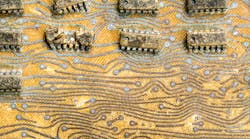To produce various products at high volume, industrial manufacturing plants rely on circuit boards and electronics to precisely and efficiently control the process from the receipt of raw materials onward. Over time, these crucial components can be compromised by processes, chemicals, and airborne vapors that promote corrosion which can result in costly unscheduled production downtime.
“Circuit boards are in everything from electronically controlled valves, starters, motors, turbines, safety switches, boiler controls, and multi-million-dollar digital control systems. These devices are exposed to all manner of corrosive environmental pollutants. Even air-conditioned circuit boards in control rooms filtered with activated carbon can become corroded,” says Bobby Williams, who has a B.S. in Chemical Engineering from North Carolina State University.
Williams notes that industrial facilities often use corrosive chemicals to process and manufacture various products. Corrosion in controls, circuit boards, and electrical systems is further accelerated by exposure to any moisture or humidity. Industrial electronic circuitry is also subject to electrolysis.
He points to a Benjamin Franklin quote to illustrate how corrosion is the root cause of much of industrial downtime when not sufficiently addressed: “For the want of a nail the shoe was lost, for the want of a shoe the horse was lost, for the want of a horse the rider was lost, for the want of a rider the battle was lost....”
Williams observes that corrosion has long been a fact of life despite the best mitigation efforts of manufacturers. “Even with built-in redundancy and extra spending on materials and protection from the elements, circuit boards and components will corrode and fail anyway,” he says.
To fight corrosion, industrial plants are turning to a unique, military-grade compound called StrikeHold that works as an anti-corrosion protectant, cleaner, and lubricant. This compound was originally developed to preserve, maintain, and lubricate U.S. military weapons and heavy equipment for use in some of the harshest working conditions in the world. Today it is used to protect circuit boards in corrosive environments in industries such as aerospace, agriculture, HVAC, heavy equipment, mining, oil and gas, and maritime operations.
The use of StrikeHold has the potential to largely eliminate the effects of corrosion and electrolysis on industrial production equipment. The compound prevents corrosion and electrolysis when applied to systems. The micro barrier that it forms on components is so complete that an electrical charge cannot be passed from the metal into water. It also improves the continuity of the connection when it is applied to both conductors of a circuit.
As an anti-corrosive protectant, it sprays on or applies wet and dries in place. A nanofilm coating protects equipment against the effects of corrosion and moisture while repelling corrosive airborne particles, dust, and dirt. The durable coating is not visible to the eye when it dries and can be reapplied as needed.
The protectant is designed to waterproof components as well as dry out wet gear and water-sensitive parts. Because it has a specific gravity greater than water (1.3 vs. 1.0 for water), when applied to a wet surface it penetrates to the hard exterior, pushes water from the surface, and coats the area.
“The anti-corrosive compound is designed to make circuit boards, electrical circuits, and metal components virtually impenetrable to corrosion and moisture while improving electrical continuity and contact,” says Williams. He was so impressed with its properties that he became managing partner of Force 5 Products, LLC, StrikeHold Brands, a chemical company that has adapted its use to the specific needs of industrial markets.
Industries like oil and gas, marine, mining, and transportation commonly use StrikeHold to clean systems, deter corrosion and ensure the safe, reliable operation of crucial electronic controls, sensors, valves, and motors.
The Metropolitan Atlanta Rapid Transit Authority (MARTA) and Northern Indiana Commuter Transportation District (NICTD), as well as several utilities and EMCs use the anti-corrosive product on their electronic circuitry and controls. The Panama Canal Authority has used it on controls and limit switches for years.
To obtain material for testing and use or technical information, contact Force 5 Products, LLC: Call Bobby Williams, Managing Director 706-216-8224; call 866-331-0572 toll-free; or visit www.strikehold.com/pages/industrial or StrikeHold at www.amazon.com.
















